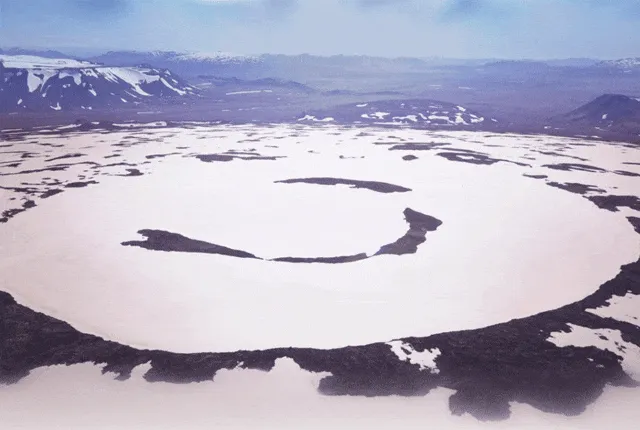Plaque Memorializes First Icelandic Glacier Lost to Climate Change
In 2014, the Okjökull was declared dead after dwindling from over 5 square miles to a mound of “dead ice”
/https://tf-cmsv2-smithsonianmag-media.s3.amazonaws.com/filer/4c/c8/4cc8adac-ccf0-4c62-94be-2444851265a0/glacier_plaque.jpg)
Next month, scientists and members of the public will trek to rocky spot in Borgarfjörður, Iceland, for a funeral of sorts. They are placing a plaque at the base of what once was the Okjökull glacier, also known as the Ok glacier, which in 2014 became the first Icelandic glacier to disappear due to climate change, reports Joe Henley at The Guardian.
Ok was not one of Iceland's most scenic or largest glacier, but it was still significant enough that the Vikings took note of it when they first settled the island. A century ago the mass of ice on the crater of an extinct volcano on the western edge of the island nation covered about 5.8 square miles and was about 165 feet thick. By 2014, however, it had dwindled to about .4 square miles of ice just 50 feet deep, losing its status as a glacier.
To be a glacier, a body of compacted ice must accumulate more mass each winter than it loses throughout the summer and constantly move under its own weight. When that process stops, the glacier essentially becomes one massive melting ice cube.
Last year, Rice University anthropologists Cymene Howe and Dominic Boyer produced a documentary about Ok, called Not Ok, telling the story of the glacier and raising its profile. The pair also led an “Un-Glacier Tour” last year to take people to view the ragged remnants of Ok. This summer, they are leading the Un-Glacier Tour II that will culminate with the placing of the plaque. The melancholy memorial, written by prominent Icelandic writer Andri Snaer Magnason, will read:
A letter to the future
Ok is the first Icelandic glacier to lose its status as a glacier. In the next 200 years, all our glaciers are expected to follow the same path. This monument is to acknowledge that we know what is happening and know what needs to be done. Only you know if we did it.
August 2019
415ppm CO2

“This will be the first monument to a glacier lost to climate change anywhere in the world,” Howe says in a press release. “By marking Ok’s passing, we hope to draw attention to what is being lost as Earth’s glaciers expire. These bodies of ice are the largest freshwater reserves on the planet and frozen within them are histories of the atmosphere. They are also often important cultural forms that are full of significance.”
Boyer tells CNN that Iceland’s glaciers are currently hemorrhaging 11 billion tons of ice mass each year. Without a significant change in warming trends, all of Iceland’s over 400 glaciers will face the same fate as Ok.
Iceland, of course, isn’t the only place losing its glaciers. In fact, if it takes 200 years for Iceland to lose its glaciers, it’s doing better than other parts of the globe. One study published in the journal Nature in April estimated that the majority of glaciers in central Europe, Western Canada and the United States will be gone by century’s end.
Another study published in June shows that Himalayan glaciers have lost about a quarter of their ice in the last 40 years and are on track to lose about 66 percent of their ice by century's end.
Losing glaciers doesn’t just mean losing pretty scenery. Seasonal meltwater from the glaciers is an important source of freshwater and power source for hydroelectric dams. The loss of glaciers will lead to reduced flows in rivers, decreased fish stocks, reduced agricultural irrigation and loss of electrical power.
Howe says that the Ok memorial isn’t just a memorial. It’s a wake up call for humanity to take the climate threat seriously.
“One of our Icelandic colleagues put it very wisely when he said, ‘Memorials are not for the dead; they are for the living,’” she says in the press release. “With this memorial, we want to underscore that it is up to us, the living, to collectively respond to the rapid loss of glaciers and the ongoing impacts of climate change.”